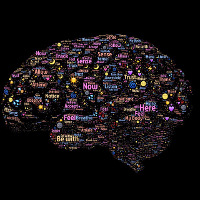Neural messages are linear, though often massively parallel, and we process our neural activity in more or less a linear manner. But just as strangely, they cannot find a memory centre in the brain, just small centres that complicate sensory processes and seem to derange self regulation. They also cannot identify a seat of consciousness, a location in the brain that controls the organization of the rest of the neural activity. The sensory signals can be tracked from apparent start to finish, but decision cannot.
I wonder how that might promote evolution of that characteristic. The “complication” I mean. Ah, complications of sensory processes? Stress and brain injury. Stress itself is anything that disturbs a cell from its previous homoeostasis. The core principle of the current notion of neuroplasticity is that neurons that fire together wire together, as they say, and also they conclude that any seriously underused neuron will eventually be pruned, as they call it.
I’m beginning to see how it could promote survival. Yes? There is such an ENORMOUS range of possible experiences in life. It would seem a good strategy for evolution to acquaint us with many of them before we actually have to encounter them.
They have been able to track the moment a sensory perception is completed. You recognize a pattern, according to their theory, not when a single synapse pathway is signalled but when enough neurons and a network are firing at the same time like a little web. This is also how the default mode network behaves which functionally and structurally is at the heart of brain function.
My image is a sort of “plasmic cloud” of neuron firings – like a flock of birds, perhaps. Excellent, good image.
I have been hopping about but maybe I can make things more coherent now. Not every aspect of neural plasticity has to do with complete pruning, eliminations of neurons, and your brain does produce and distribute new neurons from stem cells located roughly in the region of the hypo-campus. This is why they attribute formation of new memories in that area in addition to its hormonal functions. This process is greatly slowed after maturity of course.
But what would motivate those neurons to fire? Re-experiencing the original stimulus, perhaps? Well, the default mode network keeps the clock on all neural activity. Just as sensory recognition is reached when specific neurons fire in synchrony, forming a mini network, you have a network more or less at the base of your brain and centred around the core that keeps active 24/7 as they say. Sort of keeping the heart beat of the brain. When you daydream, the regions they associate with your so called higher processes quiet down, and your default mode network gets louder. The two seem to compete for resources. They figure the default mode network contains all of your higher order innate responses. Your brain stem and the small bundle at its top is able to track all your most strictly biological and instinctive behaviours, so the default mode network is more elaborate than that.
Couldn’t that mechanism quickly send someone into an OCD pattern? They have found evidence that the frontal lobe seems to be able to lock itself into a recursive loop, even incurring stress related complications in function. It fatigues and chronically overheats, so as rational as the behaviour may have been to start, it inevitably degrades, acquires big perceptual and computational holes.
I ponder “ruts” in the brain. Folds, but yes, there are chemical ruts as well, generalized as hormonal imbalances.
Your thoughts are welcome. Be well friends.
Travis Saunders
Dragon Intuitive
~science,mysticism,spirituality~

